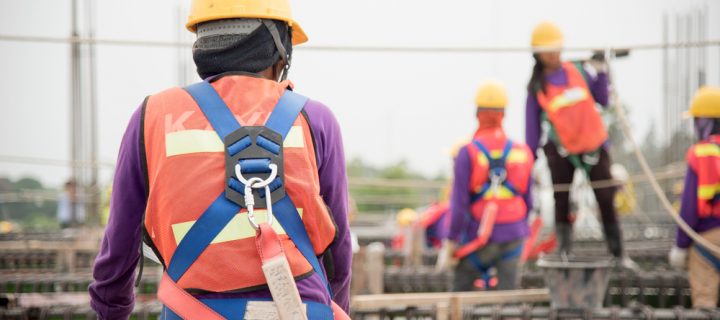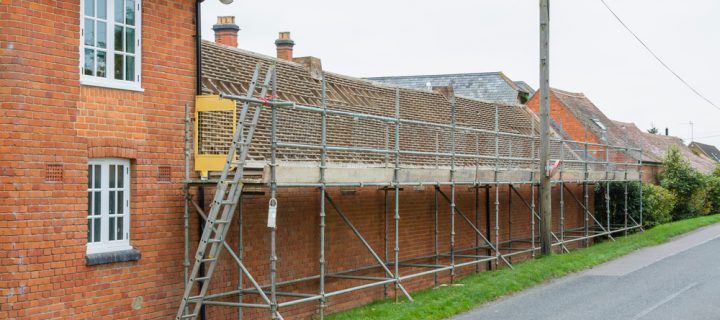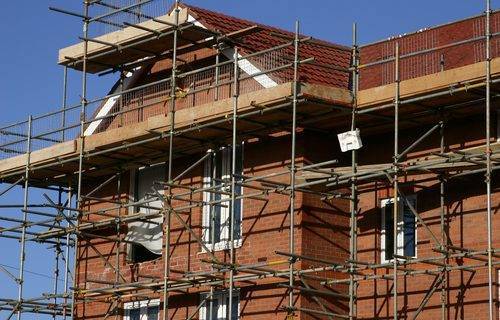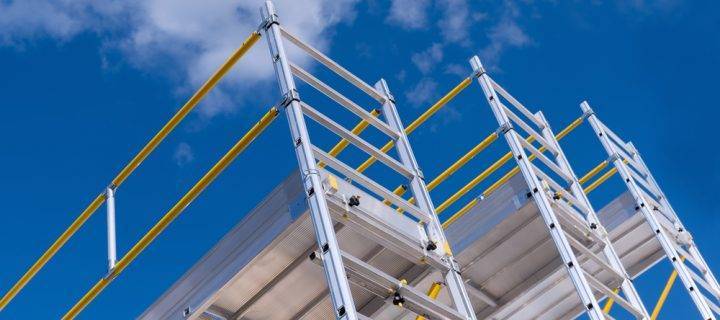A typical image from a construction site is more than likely to conjure up a half-finished building with several workers navigating around a tall steel structure known as scaffolding. This is one of the most familiar aspects of any architectural job, but why is it so important in construction? We will examine this topic during this blog. Scaffolding is installed at the start of any construction project or maintenance work. It is a temporary platform, offering support and elevation plus it enables workers to carry materials and conduct their work during the construction process. This can include repairs and cleaning but primarily its purpose is to ensure the safety of workers while the building is being maintained or built. An added caveat is that it also provides a level of support to the standing structure. 4 reasons why scaffolding is essential We have put together 4 reasons why the construction industry relies on the scaffold so much – 1. Efficiency – Scaffold provides builders and workers with a safe and secure platform to carry out their duties. The structure allows them to manoeuvre around buildings of any shape and size quickly and more efficiently. Typically they take a single day to be erected, and will essentially reduce the time spent on-site, thus making the overall project more time-efficient. 2. Safety – Working at height carries an element of danger and risk, and as we have previously mentioned a scaffold platform gives workers a safe and secure setting to carry out their tasks whilst being stationed at a considerable height. Safety appliances such as barrier netting and fencing will also ensure the health and safety of the general public below the structure. These barriers will be able to catch any loose debris and create a completely safe and secure working environment for everyone involved. 3. Easy To Access – Scaffold gives builders and workers easy access to parts of buildings that would be difficult to reach otherwise. Using bespoke scaffold structures means it can be constructed in a way to match the building design. 4. Prime Position – One of the main advantages for builders or workers is that scaffold puts them in a strategic position to carry out their...
Read Moreabout Why is scaffolding so important in construction?Safety still remains the main priority for scaffolders, after the NASC 2021 Safety Report reported the second-lowest figure for accidents and injuries throughout 2020. The NASC is one of the leading UK scaffolding trade bodies that publish their annual Safety report and contains accident statistics, analysis and plans to improve safety standards in the scaffold industry. The NASC 2021 Safety Report explained According to their statistics, just 81 incidents were reported last year; which is just 7 more than the previous year (2019), which was an all-time low. The NASC has stated that the 99.5% of its members went through the entire year accident and injury-free. Some other interesting anecdotes from the report include, the main causes of slips and trips were human error (55%), followed by poor site housekeeping and poor ground conditions (both 19%), and 69% of all recorded operative falls from height were suffered by scaffolders in the 31-40 age bracket. Lynn Way, NASC President commented, “Whilst we’re proud of the headlines figures contained within this year’s Safety Report, this publication is intended to be much more than just a line in the sand, an annual yardstick to measure general safety success against previous years. “It is also a way in which we can learn why incidents occurred with a view to developing ways in which to reduce them – benefiting both NASC members and the wider scaffolding and construction industries.” Robin James, NASC Managing Director added, “It should be remembered that during 2020 scaffolders were faced with challenging Covid-19 related working conditions, with operatives forced to significantly change the way they worked on-site. Also, they ensured that safety standards were not compromised.” The Safest Scaffolding in Derby Network Scaffold Services are the leading provider of scaffolding, for clients right across Derby and the surrounding areas. We have also recently expanded our services to include safety decking and plastic hoarding. If you would like a free no-obligation for any of our products, please do not hesitate to contact us...
Read Moreabout Safety still the main priority for scaffoldersAnyone working on erecting scaffolding should be competent or if being trained, should be supervised by a competent person. This needs to be appropriate training with regards to the type of scaffold you are using. As the minimum, every scaffold team should contain a qualified scaffolder for the type and complexity of the platform being erected. This could be an individual that has received industry recognised training such as The Construction Industry Scaffolders Registration Scheme (CISRS) or they have received training under a recognised manufacturer or supplier scheme. Are design drawings needed for my scaffold? A scaffold needs to either be erected to a recognised standard configuration (such as those in National Access and Scaffolding Confederation (NASC) document TG20 Volume 1 for tube and fitting scaffolds or a manufacturers’ guidance for system scaffolds) plus it must be designed by calculation to make sure it has sufficient strength and stability. Do harnesses need to be inspected regularly? Network Scaffold would recommend three levels of inspection for harnesses – Pre-use check – This task needs to be carried out by the user at the start of each shift to check for visible or surface defects. If there are any defects they need to be brought to the attention of the employer. Detailed Inspection – A formally recorded inspection needs to be undertaken at least every six months. For equipment that is used frequently, we would suggest that this task takes place every 3 months, particularly when the equipment is used for demolition, steel erection, steel masts/towers with edges plus scaffolding. Interim Inspection – It may also be appropriate to conduct interim inspections between detailed ones as the employer’s risk assessment could have identified significant deterioration that could affect the lanyard before the next scheduled inspection. The need for interim inspections will depend on how much the harness is used. Some examples where they may be appropriate is working environments that involve paints, chemicals or grit blasting operations or risks from acidic or alkaline environments if the lanyard’s fabric cannot be determined. Get in touch for more information If you have any questions about Network Scaffold’s accreditations, please do not hesitate to contact us...
Read Moreabout What training is needed to work on scaffolding?While you may not think that domestic roofing repairs need a professional to complete, scaffolding will be required for health and safety purposes. Before attempting roof repairs, you will need to consider how to complete the job safely whilst ensuring the building remains in a good and stable condition. If your repairs are not done properly, water will be able to get through and damage internal ceilings and walls which is costly and inconvenient to rectify. If you have doubts about your ability to fix a roofing issue, it is probably more cost-effective to talk to an expert. 5 questions to ask when considering scaffolding What are the rules? Health and safety rules will always advise having a proper risk assessment carried out if more than four people are working at height. The results will often conclude the safest way to complete this task is by using a scaffold. How big is the job? Jobs that involve working on the entire roof will always require scaffolding. These platforms are designed to keep workers at height safe and those based on the ground. If there is a risk of tools or materials falling from the roof, then a scaffold with edge protection will be needed around the platform. If materials are being passed from the roof to the ground a chute will need to be fitted to the edge of the scaffolding to allow for safe transportation. How long will the job take? If your job is likely to last more than two days, especially given the unpredictable British weather, we would always advise using a scaffold. This helps to cover up an unfinished roof plus you can protect the roof, tools and materials from adverse weather. Do I need a platform? If your repairs involve working on a chimney you should always use scaffold as a safe working platform. While there are other alternatives, none are as safe as systems from Network Scaffold as your safety is always worth investing in. When is scaffolding not needed? If your job is quite simple and takes no more than a day, using a safely secured ladder is all you will need. However, consider an alternative if there is any risk of...
Read Moreabout Do I need scaffolding for roof repairs?A warning has been issued after claims were made by scaffolding suppliers who are being targeted by suspected fraudulent customers. While it is unclear whether the spoofing scam was successful, the company involved has reported that individuals have been contacting the firm claiming to be a customer from ‘bonafide’ businesses. The individuals were spoofing the landline phone numbers of the companies to make them look like legitimate customers. They would place large value orders for scaffold materials and quote postcodes for delivery with the caller always asking for any return calls or queries to be directed to a mobile number. Scaffold trade body the NASC has sent out emails urging its UK supplier members to be vigilant of the scam. The most reliable scaffolding suppliers Network Scaffold Services are the leading provider of scaffolding, edge protection, alloy towers plus we have recently started supplying safety decking and plastic hoarding. Our team of specialists work in accordance and compliance with the latest regulatory laws. This type of work is considered dangerous with not just workers at risk as pedestrians are also at risk when health and safety measures aren’t followed. As a result, Network Scaffold have an up-to-date safety policy that outlines how we conduct our business. No matter the requirements for your site, you can rely on us to provide scaffold solutions that can be designed to ensure your project is completed on time and most importantly, safely. No-Obligation Quotes from Network Scaffold Network Scaffold offer all of our prospective clients a free no-obligation quote on all of the services we have discussed above. If you have any questions please do not hesitate to contact us and one of our experienced team will be more than happy to assist you. Alternatively, visit our FAQ section, where we have listed some of our most frequently asked questions from...
Read Moreabout Scaffolders warned regarding scam customers




